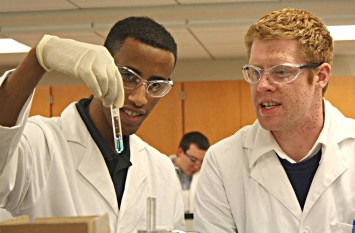
By the University of Maryland Eastern Shore’s centennial in 1986, the institution had risen above lingering doubts about its role as a four-year college in the state’s public higher education system.
The credit, most affiliated with UMES agree, goes to Dr. William P. Hytche, who was at the half-way point of his two-decade tenure as its chief executive.
UMES got a crucial boost in 1987, when philanthropist Richard A. Henson, a pioneering aviator who introduced commuter flights to the lower Eastern Shore, donated $2 million. It was the single largest gift by an individual in school history at the time.
More importantly, it signaled to the public and those controlling the purse strings in Annapolis that UMES had value. Hytche, and others, point to the Henson donation as a catalyst for change that carried into the 21st century.
The university recognized Henson’s generosity by dedicating a new building in his honor on June 24, 1994, the first significant construction project on campus in a generation. Henson’s gift leveraged other funding for a construction boom that would follow, and dramatically alter the campus landscape.
Bricks and mortar, however, were not the only changes as the university moved past its 100thanniversary.
Hytche realigned the academic programs into a template emphasizing three overarching disciplines; the School of Agricultural and Natural Sciences; the School of Education, Social Sciences, and the Arts; and the School of Business and Technology.

A graduate school would follow and eventually a fifth was added to reflect instruction in allied-health professions, including doctorates in pharmacy and physical therapy .
In the 22 years Hytche led UMES, enrollment tripled and new degree programs were added. He extended the university’s reach overseas, where its expertise in land-grant activities assisted African nations tackling food production and quality-of-life challenges.
Hytche handed over the keys to the president’s office in January 1997 to Dolores Spikes, the first woman in more than 100 years to lead the institution — and the first with previous presidential experience at Southern University.
Spikes knew and respected Hytche, and continued his strategy of focusing public attention on the important role historically Black institutions should play in higher education.
Changes in UMES’ physical appearance accelerated under Spikes. The state of Maryland constructed a new campus access road connecting U.S Route 13 to a reconfigured perimeter road around the campus. The $32 million Student Services Center opened, and its distinctive rotunda dome became the inspiration for the university’s logo.
Health problems limited Spikes’ time as president. Jackie Thomas, a UMES administrator, took over and served the 2001-2002 academic year as interim president.
The state university system’s governing board hired Thelma B. Thompson, chief academic policymaker at Norfolk State University, to be UMES’ next president. A native of Jamaica, she was the university’s first foreign-born chief executive.
Only a handful of academic programs held accreditation from peer review organizations when Thompson arrived in 2002. She directed her deputies, deans and department heads to make accreditation a priority and when she stepped down in August 2011, 26 had the credential.
Four major buildings opened during Thompson’s nine years as president; the Food Science & Technology Center, a new physical plant headquarters, a coastal research center near Assateague Island and Hazel Hall, named in honor of Salisbury businessman Richard F. Hazel.
Hazel’s $3 million gift was the largest private donation in UMES’ first 125 years and launched a successful university-wide campaign that generated $14.9 million in seven years.
During the first decade of the 21st century, UMES ramped up efforts to promote economic development linking academic expertise and research with local entrepreneurs. The Office of Technology and Commercialization had success as a business incubator, working with NASA’s Wallops Flight Facility in nearby VIrginia, and venturing into green energy production.
At the start of UMES’ 125th academic year, the university had authority to award bachelor’s degrees in 34 disciplines, master’s degrees in 13 programs and doctorates in seven areas.
A school that in 1886 welcomed nine Blacks merely hoping to get a secondary-school or vocational education had become the academic home to a racially diverse student body of more than 4,400 pursuing college degrees at three levels.


